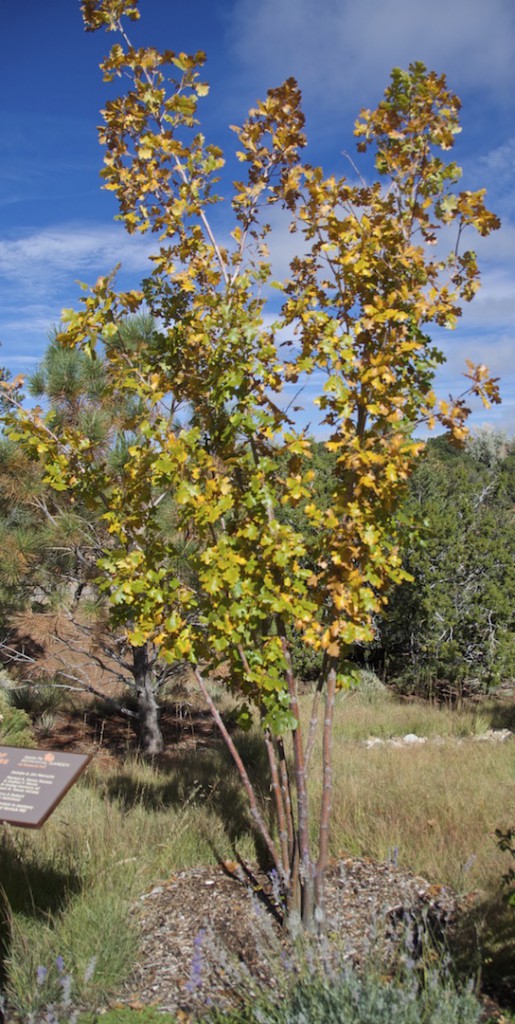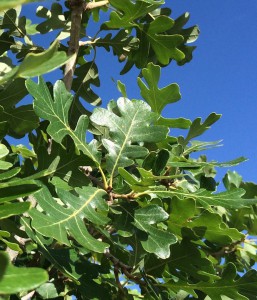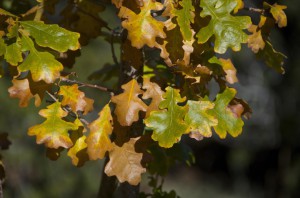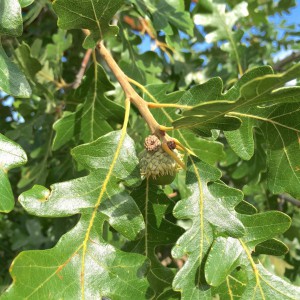Scientific name: Quercus gambelii
Common name: Gambel oak
Plant Family: Fagaceae (Beech)
Article and photos by Janice Tucker
New Mexico has wonderful native trees that do very well in the Northern New Mexico climate. These trees thrive in high altitudes and dry conditions, bringing beauty into our landscapes without nearly as much worry and maintenance as that “tree you just loved back East and want to have in your garden here”. The Gambel oak (Quercus gambelii) is a native tree that is often recommended for Santa Fe gardens and fall is its time to shine. In their natural habitat these trees often form large stands. When the Gambel oak’s leaves turn in autumn, hues of red, orange, yellow and brown can be seen spilling down a mountainside or blanketing a mesa with a patchwork palette of color. When planted in a landscaped garden, one or two Gambel oak trees will render a splash of autumnal accent.
Named in honor of American naturalist William Gambel (1823-1849) the Gambel oak, also commonly called a scrub oak, is native to most of the southwestern United States, including New Mexico. It prefers habitats of canyons, mesas, along roadsides and on mountain slopes. In the high altitude forests of 6,000 to 9,000 feet, the Gamble oak is one of the few deciduous tree species that grows among ponderosa pines, pinon pines and junipers. The Gambel oak is classified as either a small tree or large shrub and is usually multi-stemmed. The average height is 10 to 30 feet, depending on location and annual precipitation. Unfortunately it can be fire-prone but it quickly regenerates afterwards by sending up sprouts from a hardy and vigorous root system.
Most gardeners prefer keeping the Gambel oak in a tree form for landscaped areas. The deeply lobed, shiny green leaves with soft, velvety undersides provide a shady canopy in spring, summer and fall. As the days become crispy cool and the garden flowers begin to fade, the leaves turn the warm shades of autumn, satisfying that color fix that we all crave that time of year.
Gambel’s oak autumn leaves (Photo: Janice Tucker)
Spring is a busy season for the Gambel oak. It is monoecious, which means that both male and female catkins are on the same tree. The more prominent male catkins produce an abundance of pollen each spring, targeting the barely noticeable, acorn-producing female catkins. But you might want to avoid hanging around the tree during that time since the pollen coats everything, including your sinuses. Once the female catkins are pollinated, they will form acorns that are attached directly to the axes of the leaves. The acorns are small and topped with caps that resemble shaggy, woolen hats knitted with a popcorn stitch.
Gambel oaks love the sun and do not tolerate shade. They grow well in USDA Zones 4 to 8. For fire safety reasons avoid planting this or any tree close to buildings. Good drainage is a must. In its natural habitat the Gambel oak’s roots are ensconced in mostly alkaline soils but a richer soil is okay too. Thanks to its drought tolerance, water requirements are minimal after the tree is established. It is mostly maintenance-free except for monitoring any sprouts that come up from the aggressive root system. If not checked, thick clumps of trees can form, which may not be desirable in the home garden.
The Botanical Garden at Museum Hill has two young Gambel oak trees located on either side of the north ramada across the path from the Rose and Lavender Walk. These two trees have shown, significant growth especially for oak trees transplanted about 2 years ago. There is one other Gambel oak planted in the Xeric Garden that has not grown as quickly as the other two but is very healthy. It is worth a visit to see these trees in a formal landscape in order to get a visual impression of how they would look in a home garden.
The Gambel oak is an important tree used in increasing the ecosystem diversity where the tree grows naturally. Careful management in promoting the Gambel oak’s three basic growth forms of thick shrubs, pole-sized clumps and large trees helps to attain the desired biodiversity. The shrubby thickets will provide protective cover for birds and small mammals and food for browsing wildlife. The larger trees will produce a bigger crop of acorns, which are also a food source for a variety of animals. The larger trees are also more likely to have cavities that invite birds and other critters to set up residence. It is a larval host for the Colorado hairstreak butterfly.
As for traditional and medicinal uses, Native Americans have utilized the Gambel oak acorns for a variety of ceremonial, food and medicinal purposes. Ax handles, hunting clubs, furniture and baby cradles are made from the wood.
Thinking about planting a tree in your garden? Go Native! Plant a Gambel oak.
Works Cited:
Abella, Scott R., “Gambel Oak Growth Forms: Management Opportunities for Increasing Ecosystem Diversity”. United States Department of Agriculture September 2008. www.fs.fed.us/rmrs_m037.pdf.
“Find the Right Tree”. Colorado Tree Coalition, P. O. Box 808, Bloomfield, Colorado 80038-0808.
Jester, N., Rogers, K. and Dennis, F. C., “Gambel Oak Management”. Colorado State University Extension August 05, 2014. www.ext.colostate.edu.
National Audubon Society, Field Guide to Trees, Western Region. Alfred A. Knopf, Inc, New York, New York, Copyright 1980 by Chanticleer Press, Inc.
“Oak, Gambel or Scrub or Rocky Mtn. White, Quercus gambelii, Fagaceae- Beech and Oak Family”. Utah State University. www.treebrowser.org and University of Cooperative Extension, forestry.usu.edu.
Schneider, Al, “Quercus gambelii (Gambel’s Oak)” Southwest Colorado Wildflowers, http://www.swcoloradowildflowers.com/Tree%20Enlarged%20Photo%20Pages/quercus%20gambelii%201.htm
Thanks to Helen Woody and Jeanne Gozigian for proofreading this article.







